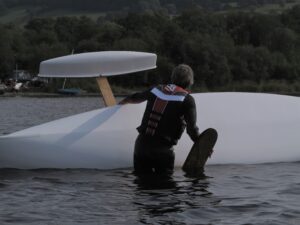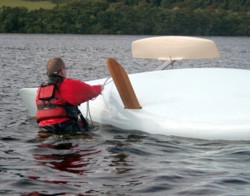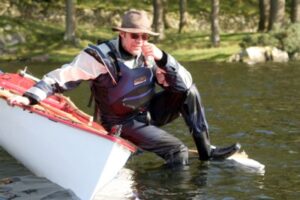When Solway Dory introduced small outriggers in 2007 the idea was to provide a bit of extra stability for novice sailors as they learned to sail. With around 40 lbs of buoyancy on an 8ft beam they gave an extra level of stability to help hold up the sailing rig if you didn’t fancy sitting up on the gunwale.
Small outriggers for use on sailing canoes
The Crossbeam
The beam is curved upwards so that the canoe can heel about 15 degrees before the outriggers hit the water, allowing the hull to provide some righting moment before the outriggers come in to contact with the water. By doing this the sailor can get used to balancing the canoe by moving their own body weight to windward. As the wind gets stronger and the canoe heels some more, the outriggers start to float and help support the force of the sail.
Sailing with the outriggers out of the water
Most of the time a competent sailor will balance the canoe with their own body weight and the outriggers will be out of the water. The outriggers still have some effect on the handling of the canoe. The outriggers and their beam increase the angular momentum of the boat. If the sail gets hit by a gust of wind the canoe feels much steadier and doesn’t lurch as quickly, giving you more time to adjust your position in the boat. In effect, the canoe feels more stable and more like a larger boat, in the same way that a tightrope walker holds a long horizontal pole to help balance themselves.
Resting on the outriggers
As the wind strengthens it is normal to sail with the outrigger just touching the water. This again makes the boat feel more stable. We soon learned that even for the very experienced canoe sailor, the outriggers make it easier and much less stressful to sail the canoe in strong winds. For several years we didn’t have a single capsize at meets, with members using outriggers. Outriggers are no longer seen as just “training wheels” for the novice and most people use them, especially on expeditions and other challenging waters. SD upgraded the outriggers to 50 lbs buoyancy a few years ago but this is as large as they can be and still allow an average-sized person to recover a capsized canoe.
Outrigger size
SD decided to make the outrigger with just one beam. Beams can get in the way of paddling and one beam is less in the way than two. This beam needs to be properly engineered. The beam is 4 inches wide so that it has enough width to support the outrigger and stop it from rotating. When SD developed their mini outriggers they were aware that dragging a cumbersome outrigger float, 4 ft out from the centre of the canoe, could have a detrimental effect on the handling of the canoe. If the outrigger was “draggy”, it could turn the canoe off the wind and make capsizing more likely. They overcame this by making the outrigger 4 feet long but only 5 inches wide. This shape has a length to beam ratio of 10-1 which produces very low drag and doesn’t have much turning effect on the canoe, even as it buries deeper in the water.
Some other outrigger systems are available on the internet, including some cheaper inflatable ones. These are usually shorter and wider in cross section and carried on a straight rather than upward curved beam. Most of them are really just designed for fishing, to provide a more stable platform whilst stationary. The high drag and flimsy beam make them unsuitable for fast sailing.
Capsizing with outriggers
As already mentioned, there were no capsizes in the group for several years when people used outriggers. Eventually a few people did. When you feel invulnerable you may forget about reefing and a few people sailed with full 54 sq ft sails in gusty Force 5 conditions and did capsize.
When Solway Dory introduced the outriggers they kept the size down to a buoyancy that could be easily submerged by your own body weight. This allows a “turtled” sailing canoe with the mini outriggers to be righted by the sailor’s own body weight. When the canoe is upside down, you can push one of the outriggers down until you can get a foot on it, next to its beam. Because they are mounted on a curved beam, it is easy to submerge the outrigger nearest to you as the opposite outrigger is also submerged and balances out the buoyancy of the nearest outrigger.

You can push the nearest outrigger quite a long way down before the opposite one comes out of the water. It is then possible to put your foot onto the beam next to the outrigger. If you hold onto the leeboard for balance and stand up, the outrigger continues to sink and the canoe comes up on its side. When the outrigger is directly under the side of the canoe you can stop pushing down on the beam and control everything with the leeboard. The buoyancy in the submerged outrigger then helps the side bags in the canoe to empty most of the water out of the canoe. Pushing down on the leeboard completes the righting and the canoe comes back upright with very little water in it.
 If you are not heavy or tall enough, then righting the canoe is easier with a line from the opposite beam to pull on. If you find that you need this, you could have a line permanently attached to the beam which could be deployed quickly. If the outriggers were any larger than 50 lbs buoyancy, or on a longer straight beam, you probably wouldn’t be able to submerge it enough to right the canoe. People who are short or very lightweight can struggle to submerge the outrigger far enough to right the boat. In this case shortening the beam should help.
If you are not heavy or tall enough, then righting the canoe is easier with a line from the opposite beam to pull on. If you find that you need this, you could have a line permanently attached to the beam which could be deployed quickly. If the outriggers were any larger than 50 lbs buoyancy, or on a longer straight beam, you probably wouldn’t be able to submerge it enough to right the canoe. People who are short or very lightweight can struggle to submerge the outrigger far enough to right the boat. In this case shortening the beam should help.
Climbing back on board the righted canoe
A canoe is quite narrow compared with modern sailing dinghies, and it can be difficult to climb back on board without capsizing again. The outriggers not only make capsizing much less likely, they make re-entering the canoe much easier as well. Because the outrigger has a buoyancy of 50lbs and is held 4ft from the centre of the canoe, it can support the weight of an average 12st (75kg) sailor sitting on the gunwale.

The outrigger reduces the chance of the sailor tipping the canoe on top of themselves as they climb back in. The upward curving beam also allows the canoe to heel towards them as they press down on the gunwale, reducing the freeboard and making it easier to get back on board. This on its own means that SD mini outriggers are worthwhile on any sailing canoe.
A heavier person may find that the SD outriggers are not large enough to prevent them pulling the canoe over on top of themselves as they try to climb back on board, so practice to make sure that they work for you. There are plans for mid-sized outriggers available that may work for you but be aware that these might not be recoverable if you do manage to capsize and turtle the canoe.